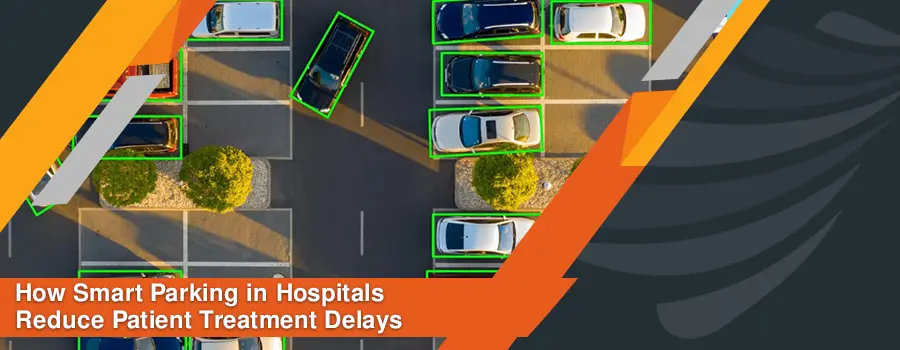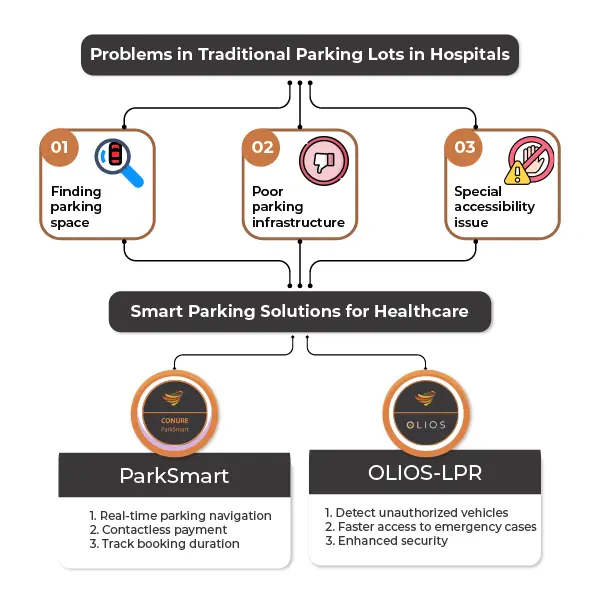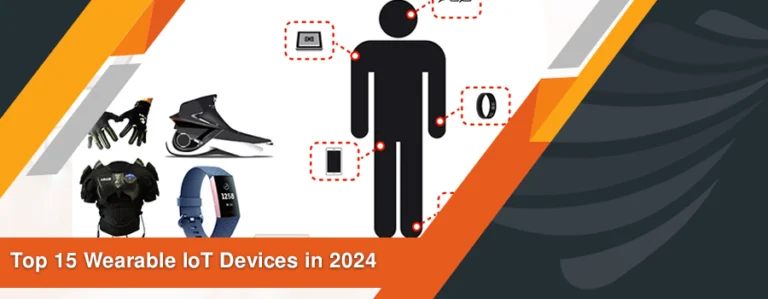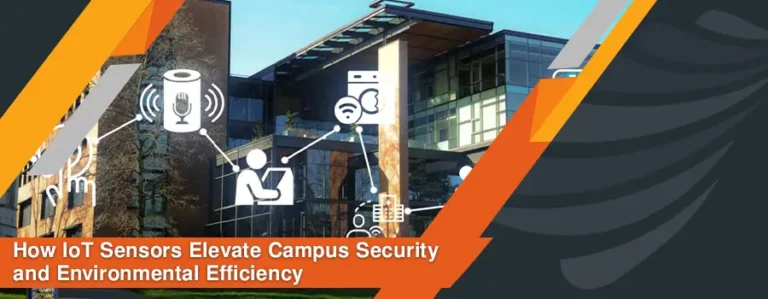Hospitals are currently facing pressing issues, including an increasing number of accident cases and public health emergencies. Every day, thousands of individuals rush to hospitals for urgent treatment for their loved ones. However, the situation is often worsened by traffic jams, parking shortages, and mismanagement, leading to patient treatment delays, deteriorating patient conditions, and even fatalities.
Hospitals are actively seeking solutions to reduce patient delays and streamline their operations. One promising avenue that instills hope is the adoption of IoT solutions like automated parking guidance systems and smart parking enforcement solutions. These innovative technologies not only have the potential to solve problems but also to transform hospital spaces, leading to faster emergency response and smoother hospital visits. This potential is something to be hopeful and optimistic about.
Let’s delve into this blog to understand how smart parking solutions lead the way and resolve parking issues that cause hurdles in inpatient treatment. Your role in implementing these solutions is not just significant; it’s crucial. Your actions can significantly impact patient care, making you an integral and valued part of the solution.
The Critical Nature of Patient Emergency Response
Hospitals receive a high number of emergency cases every hour. Whether the case is an accident, heart attack, heat stroke, suicide, or severe trauma, rapid treatment response is crucial. According to research, in 2022, around 1.87 million medical emergency cases were reported in public hospitals in Riyadh, Saudi Arabia. This data underscores the critical role each of us plays in improving our emergency response systems.
The effectiveness of emergency hospital response is influenced by several factors, including how staff mobilizes for incoming emergencies, the speed of ambulance arrivals, the time spent finding parking space at the hospital and reaching emergency centers, and the quality of hospital infrastructure. These factors underscore the need to enhance hospital infrastructure, train staff, and implement smart solutions and innovative strategies.
Challenges in Traditional Parking Lots in Hospitals
Some key challenges in traditional parking lots in hospitals are:
1. Increased Demand for Parking
During emergencies, there is a surge in visitors and patients. Overcrowded parking spaces, mismanagement, and roadblocks lead to delays in emergency response and affect patient health and the hospital’s reputation.
2. Problem in Finding Parking Space
Traditional parking management methods are inefficient at managing the high flow of vehicles and facilitating people with disabilities or in emergencies.
3. Poor Parking Infrastructure
Old infrastructure designs need to be smarter to navigate drivers to the available parking spots, making the parking experience for the drivers frustrating.
4. Special Accessibility
Hospitals struggle to provide adequate accessibility for patients with mobility issues. This makes it difficult for disabled individuals to navigate to the nearby parking space and get emergency care promptly.
Smart Parking Solutions for Hospitals
Following are the smart solutions that can facilitate hospital parking facilities:
1. ParkSmart
ParkSmart is an automated parking guidance system that uses IoT sensors. The ground-installed sensors detect occupancy status in real time and send signals to the centralized system to identify whether the specific parking space is occupied, booked, vacant, or has exceeded its booking time. This automated system ensures efficient parking allocation and allows management to charge penalties for vehicles parking more than their booking time.
Through a mobile app, they can book and pay for their parking spaces for specific times and, without any waiting or hassle, can go to the hospital and easily park their car. This avoids delays and allows patients to get treatment at the right time.
Digital signage and mobile apps further enhance the system and help visitors navigate to the nearby parking space. In the mobile app, separate color-coded markings distinguish parking spots for visitors, hospital staff, patients, and disabled individuals. This allows users to easily navigate to their desired spot, reducing confusion and congestion.
2. OLIOS LPR
OLIOS-LPR is a smart parking enforcement solution that uses license plate recognition (LPR) technology, image processing, and OCR technology to capture and identify the license plates of vehicles entering and leaving parking spaces. This streamlines the need to manually check the cars to determine whether they are unauthorized or illegal and speeds up the entry and exit process.
The system is optimized for faster identification of ambulances, granting immediate access to the designated parking zones, avoiding delays, and helping patients get immediate care. This feature is helpful in critical situations where every second matters.
The installation of OLIOS-LPR enhances parking management and ensures hospital security. Its feature of detecting unauthorized cars helps management avoid allowing cars to enter restricted areas and even detect stolen cars or those involved in criminal activities.
Key Features of Smart Parking Solutions for Healthcare
Smart parking solutions are crucial for hospitals turning towards smart applications. Upgrades are required to meet patients’ safety needs and parking and transportation issues. When someone enters the hospital,
Therefore, to gain a competitive advantage and satisfy clients and visitors, hospitals must upgrade their parking areas and smartly manage traffic flows and hospital security.
Below are the features of smart parking solutions that reduce patient treatment delays in hospitals:
1. Real-Time Navigation
ParkSmart app provides real-time navigation for drivers to find or book the parking type where they want to park. Real-time navigation to the available parking spot saves time for patients, and the separate spaces for patient parking help them avoid hassles and reach their desired department promptly.
2. Mobile App Interface
ParkSmart provides separate mobile apps for users and admins. The app is designed for admins to monitor parking lots and be notified if an unauthorized car enters or parks. They also get insights to optimize infrastructure promptly and meet patient needs.
The user mobile apps allow users to book their parking spaces, pay online, and enjoy a seamless parking experience. It also notifies them about their parking status, whether expired or not, so they can remove their cars promptly and avoid penalties. Mobile apps save time, support parking management, and prioritize patient parking and emergency responders.
However, OLIOS-LPR is only designed for the administrative level; users can’t access it.
3. Enhanced Security
Installing smart parking enforcement solutions like OLIOS-LPR supports parking management and ensures security. The license plates of vehicles entering and leaving the hospitals are scanned, allowing contactless, secure access to parking areas. For ambulances or emergency vehicles, swift access is provided to designated parking zones, which helps promptly deal with urgent medical conditions.
4. Distinct Parking Zones
ParkSmart has set up separate parking zones to ensure a seamless parking experience and prioritize patients. These areas are Reserved, General Parking, Occupied, Expired, Patient, Person with Disabilities, and Valet. They are allotted with clear markings and signage.
The ParkSmart app also shows color-coded parking spots for separate parking zones so that users only reach the parking zone where they fit. This ensures that the right spots are available for those who need them the most and reduces parking conflicts and congestion, speeding up emergency patient intake.
5. Automated Penalty Enforcement
Smart parking apps like ParkSmart track booking durations and issue penalties automatically if a vehicle overstays its reserved time. This prevents misuse of parking spaces and ensures better space management. Patients and emergency cases won’t face difficulty finding spots, and treatments won’t be delayed due to parking issues.
6. Data-driven Insights
OLIOS-LPR and ParkSmart provide admin-specified apps to monitor spaces and prevent illegal activities or mismanagement.
They also get insights into different parameters, such as the number of cars parked daily, for how many hours one parks, the number of unauthorized cars entering the parking zone, the number of parking spots occupied, available, or expired, and others. These insights help the management optimize parking layouts, hospital security, and traffic flow, improving patient access.
Challenges in the Implementation of Smart Parking Solutions in the Hospital Facility
Despite several advantages of upgrading to smart parking solutions, several hospitals still need to adopt it. The reasons are:
1. Lack of Awareness
Hospitals in underdeveloped nations run on limited budgets and facilities. Therefore, they must focus more on research, new technological updates, or infrastructure upgrades. They need to gain awareness and knowledge that smart solutions are a profitable investment, so they refrain from investing in them.
2. Limited Investment
The installation of smart parking systems includes cameras, digital signage, and mobile app infrastructure. Small hospitals or clinics may need more money, as the initial investment can be high depending on the parking area and client requirements.
3. User Adoption and Training
Both hospital staff and visitors may need training to adapt to the new system and use the mobile app, especially if the system is new in their vicinity. Also, a user-friendly interface and clear guidance are required to ensure that users can easily reach their desired parking spots and enjoy a seamless parking experience.
4. Data Privacy and Security
Both ParkSmart and OLIOS-LPR collect significant amounts of data in real time. The data is stored securely on the cloud; however, cyber-attacks and compliance with complex regulations can be concerns.
5. Maintenance and Technical Support
Smart parking solutions rely on technology that needs ongoing maintenance, monitoring, updates, and troubleshooting. Healthcare centers may need to remain in contact with service providers to keep the systems running smoothly.
Success Story: Hospitals that Have Adopted Smart Parking Solutions
One of the latest success stories is the implementation of ParkSmart, automated parking guidance, in Johns Hopkins Aramco Healthcare (JHAH) in Dhahran, Saudi Arabia. JHAH’s traditional parking system could have been more efficient and mismanaged due to a lack of signage and real-time parking availability information, leading to prolonged searches for parking spots and patient delays in treatment.
Under the ParkSmart project, around 1600 advanced sensors and digital signage were installed in the parking area, providing parking availability for thousands of patients, visitors, and staff. The new system has reduced patient wait times and parking-related delays, ensuring emergency cases get immediate access to parking zones without hassle. Space utilization efficiency also improved overall traffic flow and security, increasing the hospital’s operational efficiency.
The successful deployment of ParkSmart at JHAH reflects how smart parking solutions can meet common challenges in high-traffic environments, leading to smoother hospital visits and patient outcomes.
The Future of Smart Parking Solutions in the Healthcare Centre
Advancements in IoT, Artificial Intelligence (AI), machine learning, virtual reality, and cloud computing drive the future of smart parking solutions in healthcare centers. Hospitals will upgrade their infrastructure to meet evolving needs and provide highly secure parking environments and user-friendly interfaces.
One example is parking gamification, which includes gamification elements in the app. The gamification feature will allow users to gain points, bonuses, and rewards if they follow all the rules. Also, the integration of augmented reality allows them to see AR-based navigation to the available parking spot. These updates will further optimize operations and make it easy for the drivers to reach their spots.
Moreover, the number of EV cars is increasing; therefore, the smart parking solution will incorporate features to support these cars. Separate spaces will be designated to equip EV charging stations to provide a seamless charging experience for both visitors and staff.
Considering the increasing number of driverless cars, smart parking systems will evolve to include features such as specialized designs for driverless cars. Autonomous vehicles will integrate with a smart parking system to navigate to the available parking spot automatically without any errors. The system will optimize parking spaces based on the vehicle status, such as operational needs and battery life. Even valet-like services will be offered where autonomous cars will drop off patients or staff at their desired place and then park themselves at the desired place under the system’s real-time guidance.
These future-forward approaches will make hospital parking efficient and aligned with the evolving needs of transportation technologies.
Over To You
As the number of hospital visits increases, there is a need for smart management of vehicles reaching the hospital. Installing smart parking solutions optimizes hospital parking areas, reducing waiting times, hassles, and unnecessary congestion. Real-time navigation lets drivers quickly find their booked parking spot, allowing doctors to promptly deal with emergency cases and patient appointments. On the other hand, installing LPR systems ensures that only authorized cars enter, avoiding terrorist activities and mismanagement.
Overall, adopting smart solutions to manage traffic flows, parking, and security in the hospital helps visitors avoid unnecessary delays and improves patient outcomes and the hospital’s reputation.






